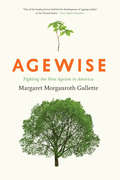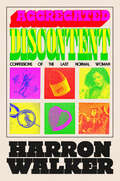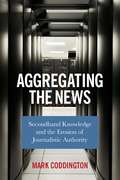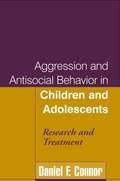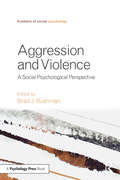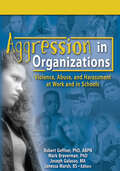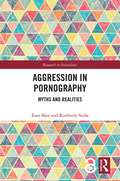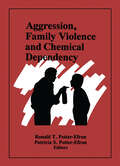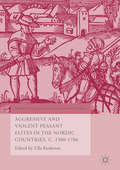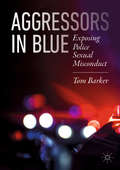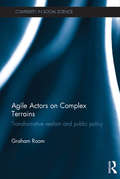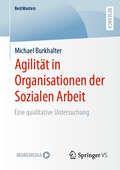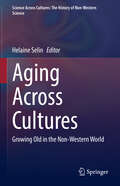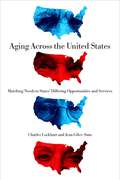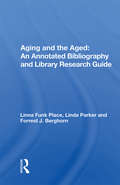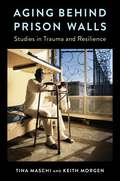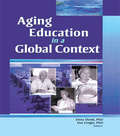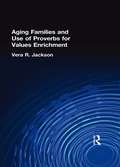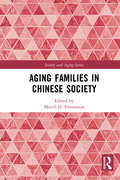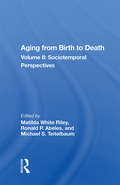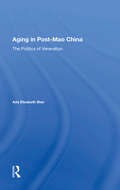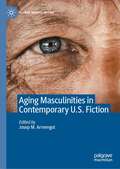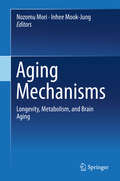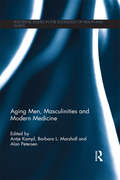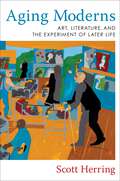- Table View
- List View
Agewise: Fighting the New Ageism in America
by Margaret Morganroth GulletteLet’s face it: almost everyone fears growing older. We worry about losing our looks, our health, our jobs, our self-esteem—and being supplanted in work and love by younger people. It feels like the natural, inevitable consequence of the passing years, But what if it’s not? What if nearly everything that we think of as the “natural” process of aging is anything but? In Agewise, renowned cultural critic Margaret Morganroth Gullette reveals that much of what we dread about aging is actually the result of ageism—which we can, and should, battle as strongly as we do racism, sexism, and other forms of bigotry. Drawing on provocative and under-reported evidence from biomedicine, literature, economics, and personal stories, Gullette probes the ageism thatdrives discontent with our bodies, our selves, and our accomplishments—and makes us easy prey for marketers who want to sell us an illusory vision of youthful perfection. Even worse, rampant ageism causes society to discount, and at times completely discard, the wisdom and experience acquired by people over the course of adulthood. The costs—both collective and personal—of this culture of decline are almost incalculable, diminishing our workforce, robbing younger people of hope for a decent later life, and eroding the satisfactions and sense of productivity that should animate our later years. Once we open our eyes to the pervasiveness of ageism, however, we can begin to fight it—and Gullette lays out ambitious plans for the whole life course, from teaching children anti-ageism to fortifying the social safety nets, and thus finally making possible the real pleasures and opportunities promised by the new longevity. A bracing, controversial call to arms, Agewise will surprise, enlighten, and, perhaps most important, bring hope to readers of all ages.
Aggregated Discontent: Confessions of the Last Normal Woman
by Harron WalkerA searing journey through the highs and lows of twenty-first century womanhood from an award-winning journalist beloved for her unflinchingly honest and often comedic appraisals of pop culture, identity, and disillusionment &“A delicious reading experience—like hearing your smartest friend eviscerate the worst person you know.&”—Sabrina Imbler, author of How Far the Light Reaches&“Such a brilliant writer, with so many surprising moves.&”—Torrey Peters, author of Detransition, Baby After a brief fling with corporate stability in her twenty-something cis era, Harron Walker has transitioned into a terminally single freelancer and part-time shopgirl. She's in the throes of her second adolescence and its requisite daily spirals. She wants it all, otherwise known as: basic human rights, a stable job with good pay and healthcare benefits, someone to love, the ability to feel safe and secure, the pursuit of satisfaction and maybe even contentment. And when she starts to acquire those things—well, as The Monkey's Paw famously asked, "What could go wrong?"In sixteen wholly original essays that blend memoir, cultural criticism, investigative journalism, and a dash of fanfiction, Walker places her own experiences within the larger context of the pressing and underdiscussed aspects of contemporary American womanhood that make up daily life. She recounts an attempt to eviscerate a corporation's attempt at pinkwashing their way into bath bomb sales while simultaneously confronting her &“pick me&” impulse to do so. She interrogates her relationship to labor, from the irony of working in a transphobic workplace in order to cover gender-affirming surgery to the cruel specter of the girlboss that none of us ever think we'll become. She explores the allure and violence of assimilating into white womanhood in all its hegemonic glory, exposes the ways in which the truth of trans women's reproductive healthcare is erased in favor of reactionary narratives, and considers how our agency is stripped from us—by governments, employers, partners, and ourselves—purely on account of our bodies.With razor-sharp, biting prose that&’s as uncompromising as it is playful, Walker grapples with questions of love, sex, fertility, labor, embodiment, community, autonomy, and body fluids from her particular vantagepoint: often at the margins, conditionally at the center.
Aggregating the News: Secondhand Knowledge and the Erosion of Journalistic Authority
by Mark CoddingtonAggregated news fills our social media feeds, our smartphone apps, and our e-mail inboxes. Much of the news that we consume originated elsewhere and has been reassembled, repackaged, and republished from other sources, but how is that news made? Is it a twenty-first-century digital adaptation of the traditional values and practices of journalistic and investigative reporting, or is it something different—shoddier, less scrupulous, more dangerous? <P><P>Mark Coddington gives a vivid account of the work of aggregation—how such content is produced, what its values are, and how it fits into today’s changing journalistic profession. Aggregating the News presents an analysis built on observation and interviews of news aggregators in a variety of settings, exploring how aggregators weigh sources, reshape news narratives, and manage life on the fringes of journalism. Coddington finds that aggregation is defined by its derivative relationship to reporting, which colors it with a sense of inferiority. Aggregators strive to be seen as legitimate journalists, but they are constrained by commercial pressures, professional disapproval, and limited access to important forms of evidence. The first comprehensive treatment of news aggregation as a practice, Aggregating the News deepens our understanding of how news and knowledge are produced and consumed in the digital age. By centering aggregation, Coddington sheds new light on how journalistic authority and legitimacy are created—and the consequences when their foundations are eroded.
Aggression and Antisocial Behavior in Children and Adolescents
by Daniel F. ConnorThis comprehensive volume reviews and synthesizes a vast body of knowledge on maladaptive aggression and antisocial behavior in youth. Written from a clinical-developmental perspective, and integrating theory and research from diverse fields, the book examines the origins, development, outcomes, and treatment of this serious problem in contemporary society. Major topics addressed include the types and prevalence of aggressive and antisocial behavior; the interplay among neuropsychiatric, psychosocial, and neurobiological processes in etiology; known risk and protective factors; gender variables; and why and how some children "grow out of" conduct disturbances. Chapters also discuss current approaches to clinical assessment and diagnosis and review the evidence for widely used psychosocial and pharmacological interventions.
Aggression and Violence: A Social Psychological Perspective (Frontiers of Social Psychology)
by Brad J. BushmanThis book provides a broad and contemporary overview of aggression and violence by some of the most internationally renowned researchers in the field. It begins with an integrative theoretical understanding of aggression and shows how animal models shed light on human aggression and violence. Individual risk factors for aggression and violence from different research perspectives are then examined. First, there is a cognitive neuroscientific, neuropsychological, and psychophysiological study of the brain. It then explores the developmental psychological factors in aggressive behavior, incorporating work on gender and the family. Other perspectives include the role of testosterone, individual differences, and whether humans are innately wired for violence. The following sections moves from the individual to the contextual risk factors for aggression, including work on the effects of adverse events and ostracism, guns and other aggressive cues including violent media, and drugs and alcohol. Targets of aggression and violence are covered in the next section, including violence against women and loved ones; aggression between social groups; and the two very contemporary issues of cyberbullying and terrorism. The book concludes with work showing how we may make the world a more peaceful place by preventing and reducing aggression and violence. The volume is essential reading for upper-level students and researchers of psychology and related disciplines interested in a rigorous and multi-perspective overview of work on aggression and violence.
Aggression in Organizations: Violence, Abuse, and Harassment at Work and in Schools
by Mark BravermanLearn guidelines for diagnosis, treatment, prevention, and intervention!As violence and abusiveness become increasingly prevalent in our schools and workplaces, our sense of safety suffers a heavy toll. Aggression in Organizations: Violence, Abuse, and Harassment at Work and in Schools presents a wide range of research, perspectives, and approaches to violence and abuse at work and in school. Respected authorities discuss practical strategies that foster a sense of safety, dignity, growth, creativity, and social support in every organization.Topics include: the quantitative and qualitative methods that document the long-term effects of trauma and the effectiveness of interventions the role of perceptions in gauging workplace hostility a personality test to identify an aggressive personality the role of organizational frustration in forming aggressive behaviors the effects of a teacher&’s emotional abuse of a student two forms of workplace abuse, "bullying" and "mobbing" and many more!Aggression in Organizations discusses in depth the effects of physical violence, sexual and emotional abuse, and bullying in various situations and institutions. Case studies illustrate examples that bring the latest empirical and applied research into clear focus. Insights are revealed into what can be done to prevent a future filled with violence as well as guidelines for treating people affected by aggressive acts. Each chapter is well-referenced and many include helpful diagrams and tables to enhance clarity.Aggression in Organizations presents and explains: an overview of workplace and school violence protection a ten year clinical case study of an incident of workplace violence factors influencing women&’s perceptions of a sexually hostile workplace the emotionally abusive workplace identifying the aggressive personality organizational frustration and aggressive behaviors creating respectful, productive workplaces emotional abuse in the classroom adult-student sexual harassment a qualitative analysis of students and parents&’ immediate reactions to the shootings at Columbine High School a school-wide bullying prevention program for elementary studentsAggression in Organizations is essential reading for psychologists, educators, organizational consultants, human resource professionals, school counselors, and social workers.
Aggression in Pornography: Myths and Realities (Research in Sexualities)
by Eran Shor Kimberly SeidaAggression in Pornography focusses on the issue of violence in mainstream pornography and examines what we know, what we think we know, and what are some surprising research findings and insights about the place of violence within pornography today. The authors first review the modern pornography industry, theoretical claims about pornography as violence, and the ways in which aggression has been defined and measured in previous research. Next, they review the findings of empirical research on violent content in pornographic materials and the potential effects of such content on audiences . The main part of the book relies on systematically collected empirical data, as the authors analyze the content of hundreds of pornographic videos as well as more than a hundred interviews with men and women who regularly watch pornography. These analyses provide surprising insights regarding the prevalence of and trends in violent content within mainstream pornography, the popularity of violent and non-violent content among viewers, and variations in aggression by race and sexual orientation. As such, Aggression in Pornography will be of interest to students and researchers in sociology, gender and sexuality studies, and media and film studies, as well as to wider audiences who are interested in today’s pornography industry and to policymakers looking to devise empirically driven policies regarding this industry and its potential effects.
Aggression, Family Violence and Chemical Dependency
by Ron Potter-Efron Patricia Potter-EfronHere is an informational and practical book that systematically addresses the complex relationships between chemical abuse/dependency, aggression, and family violence. Directed toward professional chemical dependency and family violence counselors, it provides specific guidelines for the assessment of child abuse, incest, and marital rape, as they are likely to be encountered in a chemical dependency treatment setting. Experts outline treatment suggestions for chemically dependent and codependent individuals who are or have been the victims/perpetrators of family violence. Aggression, Family Violence and Chemical Dependency contains two unique and very detailed chapters on the relationship between aggression and the use of alcohol and other mood-altering substances as well as the connections between these two and other physiological and psychological correlates of violence. mention that Ron and Patricia Potter-Efron are the authors of Letting Go of Shame (Harper & Row)
Aggressive and Violent Peasant Elites in the Nordic Countries, C. 1500-1700 (World Histories of Crime, Culture and Violence)
by Ulla KoskinenThis book investigates the forms that the aggression and violence of peasant elites could take in early modern Fennoscandia, and their role within society. The contributors highlight the social stratification, inner divisions, contradictions and conflicts of the peasant communities, but also pay attention to the elite as leaders of resistance against the authorities. With the formation of more centralised states, the elites' status and room for agency diminished, but regional and temporal variations were great in this relatively drawn-out process, and there still remained several favourable contexts for their agency. Even though the peasant elite was not a homogenous entity, the chapters in this collection present us one uniting feature - the peasant elites' tendency to assert themselves with an active and aggressive agency, even if this led to very different outcomes.
Aggressors in Blue: Exposing Police Sexual Misconduct
by Tom BarkerThis book presents a powerful and thorough investigation into police deviance and sexual misconduct in the US. Drawing on news reports, official government press releases and academic research sources, Barker examines a wide array of cases including sexual harassment, sexual abuse, child molestation and police killings, including those of prisoners behind bars. Substantiated with additional cases from the UK, Russia and beyond, analysis is also conducted of the experiences of the victims of those crimes. Aggressors in Blue argues that this misconduct has its roots in the nature of the law enforcement occupation, and outlines the typical conditions which enables police sexual abuse to take place. This is a bold new investigation which speaks to students and academics in criminal justice, criminology and social justice in particular, as well as to scholars, social justice advocates, law enforcement professionals, policy-makers and academics in other related disciplines.
Agile Actors on Complex Terrains: Transformative Realism and Public Policy (Complexity in Social Science)
by Graham RoomThis book assesses the value and relevance of the literature on complex systems to policy-making, contributing to both social theory and policy analysis. For this purpose it develops two key ideas: agile action and transformative realism. The book takes some major themes from complexity science, presents them in a clear and accessible manner and applies them to core problems in sociological theory and policy analysis. Combining complexity science with perspectives from institutionalism and political economy, this book is the first to integrate these fields conceptually, methodologically and in terms of the implications for policy analysis and practice. Room shows how the models and methods of social and complexity science can be jointly deployed and applied to empirical areas of public policy. He demonstrates how complexity science can provide insight into the nonlinear dynamics of the social world, but why these need to be understood by reference to the unequal distribution of power and advantage. Among the sociological debates with which the book engages are those concerned with causation and explanation, rational action and positional competition, and the place of evolutionary concepts in accounts of social change. Among the policy debates are those concerned with evidence and policy, the dynamics of inequality, and libertarian paternalism. The book will appeal to final year undergraduates and postgraduate students in social sciences; scholars in social and policy studies broadly defined; policy-makers who want to go beyond conventional discussions of evidence-based policy-making and cross-national lesson-drawing, and consider how to approach complex and turbulent policy terrains; and a wider range of scholars in other disciplines where complexity science is already well developed.
Agilität in Organisationen der Sozialen Arbeit: Eine qualitative Untersuchung (BestMasters)
by Michael BurkhalterIn dem vorliegenden Buch wird Agilität in Organisationen der Sozialen Arbeit untersucht und der Fragestellung nachgegangen, inwiefern eine agile Projektmanagementmethode wie Scrum auf Organisationen der Sozialen Arbeit übertragen werden kann. Durch komplexe Einflüsse aus Umwelt und Gesellschaft werden neue Herausforderungen an die Soziale Arbeit sowie deren Organisationen herangetragen, die einen veränderten Umgang zur Bearbeitung sozialer Probleme erfordern. Agilität bietet als ganzheitliches Konzept einen Lösungsansatz, um in einer veränderten Form reagieren zu können. Dies geht mit einer Vielzahl agiler Methodiken einher. Die qualitative Untersuchung zeigt, dass Agilität organisationale Bedingungen und Logiken erfordert. Sowohl das individuelle Mindset, die Kultur und Strukturen der Organisation sowie das Leadership müssen berücksichtigt werden. Nicht zuletzt leistet die Untersuchung mehrere Ansätze und praktische Herangehensweisen, mit denen, beispielsweise durch den Modellversuch «socialScrum», Agilität in Organisationen der Sozialen Arbeit bei der Bearbeitung sozialer Probleme gelingen kann.
Aging Across Cultures: Growing Old in the Non-Western World (Science Across Cultures: The History of Non-Western Science #10)
by Helaine SelinThis volume brings together chapters about aging in many non-Western cultures, from Africa and Asia to South America, from American Indians to Australian and Hawaii Aboriginals. It also includes articles on other issues of aging, such as falling, dementia, and elder abuse. It was thought that in Africa or Asia, elders were revered and taken care of. This certainly used to be the case. But the Western way has moved into these places, and we now find that elders are often left on their own or in institutions, as younger people have migrated to other cities and even countries. Grandparents often find themselves being parents to their grandchildren, a far cry from the kind of life they believed they would have as they aged. This book will explore all these issues and will be of use to students and researchers in this relatively new field.
Aging Across the United States: Matching Needs to States’ Differing Opportunities and Services
by Charles Lockhart Jean Giles-SimsOlder Americans experience stages of aging with distinct priorities. For younger retirees, climate can be most important; for older retirees, quality of health care. Various states support these and other priorities to sharply different degrees. While many Americans know which states offer mild climates for outdoor recreation, they rarely know which states offer the best medical care to Medicare patients. This book tells them and suggests sequential moves to take advantage of states’ varying strengths.
Aging And The Aged: An Annotated Bibliography And Library Research Guide (New Horizons In Marketing Ser.)
by Linna Funk PlaceThis book introduces undergraduates to library research in the field of gerontology and focuses on the wide variety of sources available for research. It covers physiological and psychological aspects of aging; social aspects of aging; and environmental aspects of aging.
Aging Behind Prison Walls: Studies in Trauma and Resilience
by Tina Maschi Keith MorgenToday, more than 200,000 men and women over age fifty are languishing in prisons around the United States. It is projected that by 2030, one-third of all incarcerated individuals will be older adults. An already overcrowded and underserved prison system is straining to manage the needs of incarcerated older adults with growing frailty and health concerns. Separated from their families and communities despite a low risk of recidivism, incarcerated older adults represent a major social-justice issue that reveals the intersectional factors at play in their imprisonment. How do the people aging in prison understand their life experiences?In Aging Behind Prison Walls, Tina Maschi and Keith Morgen offer a data-driven and compassionate analysis of the lives of incarcerated older people. They explore the transferable resiliencies and coping strategies used by incarcerated aging adults to make meaning of their lives before, during, and after imprisonment. The book draws on extensive quantitative and qualitative research as well as national datasets. It features rich narrative case studies that present stories of trauma, coping, and well-being. Based on the data, Maschi and Morgen present a solution-focused caring-justice framework in order to understand and transform the individual- and community-level structural factors that have led to and perpetuate the aging-in-prison crisis. They offer concrete proposals—at the community and national policy levels—to address the pressing issues of incarcerated elders.
Aging Education in a Global Context
by Dena Shenk Lisa GrogerA selection of proceedings from the 2004 Association for Gerontology in Higher Education annual conference Aging Education in a Global Context is a carefully considered set of papers based on selected proceedings from the 2004 Association for Gerontology in Higher Education annual conference. Each forward-thinking presentation provides unique perspectives on teaching resources and education, presenting a wellspring of creative ideas for new and experienced teachers in gerontology and aging education. Respected educators present cutting-edge concepts and effective strategies in gerontology curriculum development and cross-cultural perspectives for advancing gerontology as a field of study. Over the next twenty years, the world's aging population will increase dramatically, requiring increased attention to global aging issues. To prepare gerontologists around the world for future challenges, Aging Education in a Global Context provides educators with fresh viewpoints and practical information on which to base the latest teaching strategies. Each presentation provides a multitude of valuable ideas perfect for incorporating into aging education curriculums, such as how to use films and literature for teaching about aging, how to enfold global perspectives into aging courses, and how to avoid cross-cultural misunderstandings when teaching gerontology in a host country. This invaluable resource is extensively referenced.Aging Education in a Global Context examines aging education, issues, and ageism topics such as: the consequences of globalization for older people a course design incorporating cross-cultural, anthropological approaches to understanding aging an approach to teach about death and dying through the cross-cultural viewpoint of various religious faiths a study of fourteen international films that provides gerontologists with models of successful aging to pass on in coursework teaching cross-cultural aging using Chilean literary portrayals of elders the evolution and present state of gerontology education in Japan gerontology research and cooperative education in Kenya educating about community-based long-term care in ChinaAging Education in a Global Context presents a wealth of new ideas for all gerontology educators and educators addressing cross-cultural aging issues within discipline-based courses in sociology, social work, anthropology, public policy, and psychology.
Aging Families and Use of Proverbs for Values Enrichment
by Vera R JacksonThose providing services to older persons must develop intervention strategies that are relevant to their clients’life experiences. Aging Families and Use of Proverbs for Values Enrichment presents administrators, practitioners, educators, researchers, and students with intervention models that acknowledge and build upon the proverbs orientation of the older client. This insightful book offers information from contributing authors who have professional and personal experience with the use of proverbs. Proverbs, pithy sayings that underline basic life truths, are shown in this book to work as transmitters of values and as assessment tools.To improve the ability of service programs addressing the needs of older persons, Aging Families and Use of Proverbs for Values Enrichment delineates existing approaches that are low-cost or no cost to the service provider and beneficial to older persons. Moreover, these practices are considered within the context of a conceptual model of proverbs intervention programs for older persons that takes into consideration principles of care, cultural diversity, and family traditions. Contributors examine human competencies, coping mechanisms, and limitations, as well as other more general topics: Rehabilitation: Dispels the myth that older persons can not break long-term habits and learn new things that will improve their lives. Intergenerational Transmission: Discusses family-oriented and cultural values that are passed down from generation to generation via oral tradition. Coping with Life Events: Addresses proverbs as coping mechanisms for surviving the social transitions of life. Health and Health Care: Dispels the myth that some health care practices are taboo among older persons. Cultural and Family Ties: Discusses proverbs as the cornerstone of family sharing regarding life’s lessons. Spirituality: Contrasts African American religiosity with spirituality. Discusses proverbs as messages of faith and hope.Any person who provides services to older persons--social workers, counselors, physicians, nurses, ministers and other members of the clergy, speech and physical therapists, rehabilitation counselors, and family therapists--can benefit from using proverbs, as shown in this book, in their care approach.
Aging Families in Chinese Society (Society and Aging Series)
by Merril D. SilversteinDeclining fertility rates and increased life expectancies over the last few decades have conspired to make China one of the more rapidly aging societies in the world. Aging Families in Chinese Society focuses on the accelerated social and demographic changes in China and examines their implications for family care and support for older adults. Contributors to this landmark volume portray various challenges facing aging families in China as a result of reduced family size, changing gender expectations, rapid economic development and urbanization, rural-to-urban migration, and an emerging but still underdeveloped long-term care system. Divided into four thematic areas – Disability and Family Support; Family Relationships and Mental Health; Filial Piety and Gender Norms; and Long-term Care Preferences – chapters in this volume confront these burgeoning issues and offer salient policy and practice considerations not just for today’s aging population, but future generations to come. Combining quantitative data from social surveys in China, comparative surveys in Taiwan and Thailand, and qualitative data from in-depth interviews, Aging Families in Chinese Societies will be of significant interest to students and researchers in aging and gerontology, China and East Asian Studies and population studies.
Aging From Birth To Death: Volume 2, Sociotemporal Perspectives
by Michael S. Teitelbaum Ronald P. Abeles Matilda White RileyThis book provides deeper understanding of the aging process, of the likely differences between the lives of past and future generations, and of the potential for optimizing these future lives from cross-cultural and cross-temporal perspectives.
Aging In Post-mao China: The Politics Of Veneration
by Ada Elizabeth SherThis case study of Shenyang, the industrial capital of Liaoning Province, explores what it means to be old in the People's Republic of China, especially in terms of religious and ethical traditions, education, health, and current political, economic, and employment trends. .
Aging Masculinities in Contemporary U.S. Fiction (Global Masculinities)
by Josep M. ArmengolThis book focuses on representations of aging masculinities in contemporary U.S. fiction, including shifting perceptions of physical and sexual prowess, depression, and loss, but also greater wisdom and confidence, legacy, as well as new affective patterns. The collection also incorporates factors such as race, sexuality and religion. The volume includes studies, amongst others, on Philip Roth, Paul Auster, Toni Morrison, Ernest Gaines, and Edmund White. Ultimately, this study proves that men’s aging experiences as described in contemporary U.S. literature and culture are as complex and varied as those of their female counterparts.
Aging Mechanisms: Longevity, Metabolism, and Brain Aging
by Nozomu Mori Inhee Mook-JungThis book brings together the most up-to-date information on recent research results of leading laboratories on aging science in East Asia, particularly in Japan, Korea, and Hong Kong. Starting with a comprehensive overview of various hypotheses on biological mechanisms of aging by Dr. Sataro Goto, each chapter covers broad aspects of the most recent findings in aging-related topics: centenarian studies and genome analysis of progeria, metabolic biochemistry and neurobiology, longevity controls in yeast and nematodes, oxidative stress and calorie restriction, and neurodegeneration mechanisms in Alzheimer's and Huntington's diseases, with further potential therapeutic approaches to these age-related neurodegenerative diseases. Also included, in part, is a summary and the outcomes of a scientific discussion forum called the Asian Aging Core for Longevity (AACL) that has been held annually alternating between Japan and Korea during the last decade. This book can serve as a useful resource for finding appropriate collaborators in the areas it covers. The target readership is made up of graduate students and researchers at universities, medical and/or life-science schools, and biomedical and pharmaceutical institutes. Why does aging exist? How do we age? How is each organism's lifespan determined? These are fundamental questions in the field. We may be still far from achieving a complete view of aging mechanisms, but this book, Aging Mechanisms, offers an excellent opportunity to become familiar with the most updated progress in the biomedical research of aging in Japan and Korea, the two leading nations for human longevity.
Aging Men, Masculinities and Modern Medicine
by Alan Petersen Antje Kampf Barbara L. MarshallAging Men, Masculinities and Modern Medicine explores the multiple socio-historical contexts surrounding men’s aging bodies in modern medicine from a global perspective. The first of its kind, it investigates the interrelated aspects of aging, masculinities and biomedicine, allowing for a timely reconsideration of the conceptualisation of aging men within the recent explosion of social science studies on men’s health and biotechnologies including anti-aging perspectives. This book discusses both healthy and diseased states of aging men in medical practices, bringing together theoretical and empirical conceptualisations. Divided into four parts it covers: Historical epistemology of aging, bodies and masculinity and the way in which the social sciences have theorised the aging body and gender. Material practices and processes by which biotechnology, medical assemblages and men’s aging bodies relate to concepts of health and illness. Aging experience and its impact upon male sexuality and identity. The importance of men’s roles and identities in care-giving situations and medical practices. Highlighting how aging men’s bodies serve as trajectories for understanding wider issues of masculinity, and the way in which men’s social status and men’s roles are made in medical cultures, this innovative volume offers a multidisciplinary dialogue between sociology of health and illness, anthropology of the body and gender studies.
Aging Moderns: Art, Literature, and the Experiment of Later Life
by Scott HerringWhat happens when the avant-garde grows old? Examining a group of writers and artists who continued the modernist experiment into later life, Scott Herring reveals how their radical artistic principles set out a new path for creative aging.Aging Moderns provides portraits of writers and artists who sought out or employed unconventional methods and collaborations up until the early twenty-first century. Herring finds Djuna Barnes performing the principles of high modernism not only in poetry but also in pharmacy orders and grocery lists. In mystery novels featuring Gertrude Stein and Alice B. Toklas along with modernist souvenir collections, the gay writer Samuel Steward elaborated a queer theory of aging and challenged gay male ageism. The Harlem Renaissance dancer Mabel Hampton dispelled stereotypes about aging through her queer of color performances at the Lesbian Herstory Archives. Herring explores Ivan Albright’s magic realist portraits of elders, Tillie Olsen’s writings on the aging female worker, and the surrealistic works made by Charles Henri Ford and his caregiver Indra Bahadur Tamang at the Dakota apartment building in New York City.Showcasing previously unpublished experimental art and writing, this deeply interdisciplinary book unites new modernist studies, American studies, disability studies, and critical age studies. Aging Moderns rethinks assumptions about literary creativity, the depiction of old age, and the boundaries of modernism.
